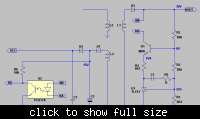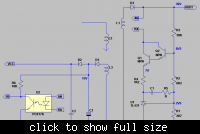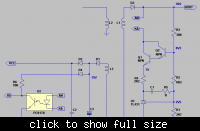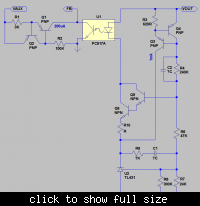eem2am
Banned
Hello,
I am doing an offline flyback with vout = 36V at 22W.
(the PWM controller is to be NCP1217)
This is how i initially intended to do the feedback circuit...........
TL431 FEEDBACK CIRCUIT with bias resistor
https://i56.tinypic.com/2znpahh.jpg
...The TL431 is only rated up to 36V, so i need the 20V zener as in the above diagram.
As you know, the TL431 requires bias current of 1mA. (hence the R(bias) )
.....this bias current must of course be supplied in times of both heavy and light load....
....this is where the light-load-efficiency conundrum starts because ........
If the bias resistor, R(bias), can pass 1mA during times of heavy load, then during times of light load , it will unfortunately end up passing more current..............in fact, in times of light load R(bias) will pass almost four times as much current, due to the greater voltage across it in light load.
This is not acceptable , so i thought of getting rid of the bias resistor and inserting a cheap current source as follows:-
TL431 with current source (PSSI2021):-
https://i52.tinypic.com/2m6st8z.jpg
Do you believe that this circuit is OK?
Am i correct in presuming that the PSSI2021 current source will always provide 1mA or less into the cathode pin of TL431, during light and heavy load times?
PSSI2021 CURRENT SOURCE DATASHEET:
**broken link removed**
TL431 DATASHEET:
https://www.fairchildsemi.com/ds/TL/TL431A.pdf
I am doing an offline flyback with vout = 36V at 22W.
(the PWM controller is to be NCP1217)
This is how i initially intended to do the feedback circuit...........
TL431 FEEDBACK CIRCUIT with bias resistor
https://i56.tinypic.com/2znpahh.jpg
...The TL431 is only rated up to 36V, so i need the 20V zener as in the above diagram.
As you know, the TL431 requires bias current of 1mA. (hence the R(bias) )
.....this bias current must of course be supplied in times of both heavy and light load....
....this is where the light-load-efficiency conundrum starts because ........
If the bias resistor, R(bias), can pass 1mA during times of heavy load, then during times of light load , it will unfortunately end up passing more current..............in fact, in times of light load R(bias) will pass almost four times as much current, due to the greater voltage across it in light load.
This is not acceptable , so i thought of getting rid of the bias resistor and inserting a cheap current source as follows:-
TL431 with current source (PSSI2021):-
https://i52.tinypic.com/2m6st8z.jpg
Do you believe that this circuit is OK?
Am i correct in presuming that the PSSI2021 current source will always provide 1mA or less into the cathode pin of TL431, during light and heavy load times?
PSSI2021 CURRENT SOURCE DATASHEET:
**broken link removed**
TL431 DATASHEET:
https://www.fairchildsemi.com/ds/TL/TL431A.pdf



